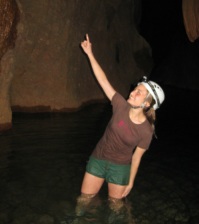Week 7: Inspiration from afar and nearbyby Natalie Punt My inspirations and motivation come from many sources. Good science especially motivates me. Science that changes the frontier of knowledge and how it is applied inspires me to challenge what I know and drives me to create. I am also inspired by the knowledge, drive and courage of innovative scientists whom change the way we think about science through their ideas. It’s no surprise that my greatest sources of inspiration are the scientists who have changed their respective fields with their ideas, especially in genomics. Genomics, or the study of all the genes that make up an organism, is changing faster than Moore’s law predicted. Innovations within genomics are profoundly influencing technology, biology and medicine. I am inspired by the prominent scientists in this field, such as Elaine Ostrander, Vadim Gladyshev, Eric Lander and George Church. Their findings contribute to multiple fields and technology. For example, in the process of developing the complete sequence of the dog’s genome, Elaine Ostrander identified genes responsible for the dog’s unique biology and contributed to the development of genome sequencing technology. Geneticists often take ask simple questions and use logical deductions to obtain their answers. As the amount of genomics data increases, geneticists rely upon sheer mathematical power to conduct their research. Genomics inspires me to keep my science real and look for simple explanations to valid problems in medicine. Similarly, their creative approaches to answer research questions inspires me to be creative in my own research and daily life. It’s great having true revolutionaries working in your field to serve as daily doses of inspiration. However, I have sources of inspiration that are closer to home. I admire our Assistant Dean of Research, Dominique Griffon for her tireless work ethic and ambitious research plans. In addition, her commitment to a high level of standards inspires me to value my personal standards of quality and work relentlessly to achieve those standards despite criticism. My mentor, Kristopher Irizarry, inspires me to be brilliant on a daily basis and to have intellectual fun. Lastly, the creativity and work ethic my colleagues demonstrate also inspire me to develop my personal style of research and productivity. Inspiration is often overridden by a constant stream of data analysis. Yet, without an idea, thought or mentor to inspire your research- there would be no data to analyze. Surrounding yourself with inspiration, such as the Scientista community can motivate individuals be innovative and create science that changes the way we perceive the world. About the Blogger
0 Comments
Your comment will be posted after it is approved.
Leave a Reply. |
The Lab JournalWelcome to the summer internship series of 2012! Follow 9 Scientista bloggers through their summer internships to catch a glimpse of what it is like to be a scientista^TM. By Title- India Presents: A "New World Symphony"
- Through The Lens: The Intricacies Of Diabetes - Do Nanoparticles Glow? - Using Unusual Animals to Study Human Disease - Using the Hubble Telescope - You Think What You Eat - Experimenting With the Life of a Scientist(a) - 18.085: My Summer at MIT - Science Heals: A Summer of Global Health Research By BloggerRabeea Ahmed
Riana Balahadia Shaira Bhanji Nzuekoh Nchinda Amy Beth Prager Natalie Punt Juliet Snyder Pin-Wen Wang Stephanie Wang Archives |
The Scientista Foundation, Inc. All Rights Reserved © 2011-2021 | Based in NY | [email protected]
The Network for Pre-Professional Women in Science and Engineering
The Scientista Foundation is a registered 501(c)(3) -- Donate!
The Network for Pre-Professional Women in Science and Engineering
The Scientista Foundation is a registered 501(c)(3) -- Donate!


 RSS Feed
RSS Feed